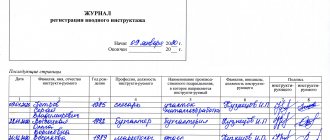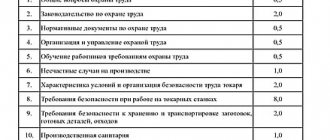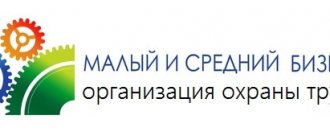Work in the field of labor protection must be organized at enterprises or organizations. According to established standards, if the total number of employees exceeds 50 people, then the position of an engineer in this area should be introduced. This employee is entrusted with the functions of conducting introductory briefings and monitoring documents on labor protection at the enterprise.
What local documents regulate
State regulations set out the requirements that must be observed by legal entities and individuals in the process of carrying out production and other activities:
- in construction - during the design, construction of buildings, reconstruction;
- during operation of objects;
- designing equipment, various mechanisms, machines;
- development of technological processes;
- labor organization.
At the level of local regulations (LNA), the employer approves documents that further determine:
- how the occupational safety and health management system (OSMS) will function;
- the procedure for the safe performance of all types of work - it is prescribed in detail how this or that operation is performed;
- procedure for equipment operation and maintenance.
Office work on labor protection is included in the general document flow of the enterprise.
The procedure for the development and adoption of local regulations
The Labor Code of the Russian Federation (LC RF) introduces the concept of “ local regulatory acts of an organization containing labor law norms .”
According to Art. No. 8 and No. 22 of the Labor Code of the Russian Federation, the employer (with the exception of employers - individuals who are not individual entrepreneurs) has the right to adopt local regulations that may contain labor law norms, but only within their competence and in accordance with laws and regulations. other regulatory legal acts (LLA), collective agreement and other agreements.
It is necessary that local regulations (LNA) meet the following principles:
- did not contradict federal laws and other legal acts of the Russian Federation and its constituent entities;
- did not contain standards that could worsen the situation of workers in comparison with the legislation on labor and its protection;
- must operate within the boundaries of this organization only.
The employer must itself comply with local regulations and, at the same time, familiarize employees, upon signature, with the adopted LNA, directly related to the work activities of these employees.
In cases provided for by the Labor Code of the Russian Federation, laws and other legal acts of the Russian Federation, collective agreements and other agreements, the employer, when adopting local regulations containing labor law norms, is obliged to request the opinion of the representative body of employees, if it exists in the given organization .
Local regulations that worsen the situation of the organization’s employees in comparison with labor legislation and other regulations containing labor law norms, collective agreements, agreements or those that were adopted without compliance with what is provided for in Art. No. 372 of the Labor Code of the Russian Federation, the procedure for taking into account the opinions of the representative body of employees, are considered invalid. In this case, laws or other regulations containing labor law norms, a collective agreement or agreement must come into force.
Employee representatives in an organization are trade unions or other representatives who are elected by the employees of that organization. If there is no primary trade union organization at the enterprise or if there is a trade union that unites less than half of the employees, at the general meeting they can entrust the representation of their interests to the mentioned trade union or other representative.
If a permanent representative body of employees has not been formed and employees cannot exercise their right to choose representatives, then the employer has the right to adopt local regulations on his own.
Local regulations may have a validity period, for example, job descriptions and other similar acts, or they may be of unlimited duration, such as orders on the distribution of responsibilities.
List of required documents on labor protection
The set of labor protection documents can be divided into 4 parts:
- external documents that contain rules for the operation of devices and equipment, safety requirements when using tools, information about the degree of danger of certain materials, certificates of conformity;
- organization management documentation;
- department documents;
- documents at workplaces.
The list of necessary documents on labor protection in an organization includes:
- Orders:
- on the organization of work on labor protection and ensuring safe working conditions;
- on the creation of a service or department for labor protection (relevant in organizations with more than 50 employees);
- on the creation of a labor protection commission;
- on appointing employees responsible for safety during the operation of various installations and equipment;
- on the appointment of those responsible for carrying out high-risk work (separate orders appoint those responsible for electrical facilities, gas facilities, fire safety, technical operation of buildings and structures);
- on the development of labor protection instructions indicating those responsible;
- on approval of labor protection instructions;
- on extending the validity of instructions or revising and amending them;
- on approval of instructions on fire safety measures and behavior in case of fire;
- on the procedure for assigning electrical safety group I to non-electrical personnel;
- on the appointment of a commission on SOUT;
- on conducting training and testing knowledge on labor protection of the organization’s employees;
- on the creation of a commission to test knowledge of labor protection requirements and safe work methods.
- Lists:
- current instructions on labor protection (by type of activity);
- positions and professions of employees who are exempt from on-the-job training;
- positions and professions of employees who need to be assigned electrical safety group I;
- positions and professions of workers who require an electrical safety group (from II and above);
- high-risk work;
- workplaces with harmful and (or) dangerous working conditions;
- professions and positions of employees who are required to wear personal protective equipment (the types of equipment, required quantity, terms of use must be indicated), as well as neutralizing agents;
- a list of employees by name who are required to undergo preliminary and periodic medical examinations.
- Magazines:
- introductory training on labor protection;
- on-the-job training;
- taking into account labor protection instructions;
- recording of workplace accidents;
- accounting for the issuance of labor protection instructions;
- accounting for fire safety briefings;
- accounting for the assignment of electrical safety group I to non-electrical personnel;
- registration of labor protection work.
Mandatory labor protection documents also include:
- internal regulations of the organization;
- job descriptions of employees - indicate responsibilities in the field of labor protection;
- regulations on the organization of labor protection work;
- instructions on labor protection and fire safety measures;
- training programs;
- occupational safety training programs;
- training and knowledge testing schedules;
- certificates for testing knowledge of labor protection, fire-technical minimum;
- acts on the investigation of industrial accidents, cases of occupational diseases;
- personal cards for recording the issuance of personal protective equipment and disinfectants;
- schedule of periodic medical examinations, reports on the results of their conduct;
- documentation on SOUT;
- regulatory legal acts that contain labor protection requirements that correspond to the specifics of the enterprise.
The absence of organizational and administrative documents on labor protection is a violation of labor legislation.
Occupational safety and health at the enterprise: documents for the work of an occupational safety specialist
To organize the work of the enterprise OT service, you need:
1. Orders on: • creation of an OT service. These responsibilities can be performed by: 1 specialized specialist, a team of specialized specialists, a trained employee from the engineering staff or a third-party specialist; • appointment of responsible persons; • approval of the list of instructions on occupational safety and their implementation; •formation of a commission on occupational safety.
2. Provisions on: • tag system; • organization of particularly dangerous work; • step-by-step monitoring of OT status; • the work of authorized employees; • development of occupational safety instructions; • occupational safety management system.
3. Instructions for occupational safety during the performance of various jobs and for professions that are provided for in the staffing table;
4. Journals: • issuing instructions; • registration of instructions, work permits, inspections by regulatory authorities, higher organizations; • accounting of accidents (AC): related, not related to production, domestic; • recording of occupational diseases (OD);
5. List of works associated with increased danger;
6. Plans: • inspections by divisions of the enterprise; • work of the OT service for the reporting period (month, quarter, year);
7. Acts of investigation of all NS and PP.
Regulatory acts that regulate the development of a set of documents
Local documents on labor protection are developed on the basis of the Labor Code of the Russian Federation, as well as Federal laws:
- dated December 28, 2013 No. 426-FZ “On special assessment of working conditions”;
- dated July 24, 1998 No. 125-FZ “On compulsory social insurance against industrial accidents and occupational diseases”;
- dated July 21, 1997 No. 116-FZ “On industrial safety of hazardous production facilities.”
Decree of the Government of the Russian Federation of December 27, 2010 No. 1160 “On approval of the regulations on the development, approval and amendment of regulatory legal acts containing state regulatory requirements for labor protection” to regulatory legal acts on labor protection, which also must be relied upon when developing a package of documents, attributed:
- occupational safety standards;
- rules and standard instructions on labor protection;
- sanitary and epidemiological rules and regulations, which stipulate the requirements for the factors of the working environment and the labor process.
When developing a list of documents on labor protection at an enterprise, the following requirements for labor protection documents must be taken into account:
- LNA must not contradict Federal legislation and state regulations in the field of labor protection;
- should not contain standards that worsen the employee’s position in comparison with that prescribed in the Federal Labor and Labor Protection Legislation;
- internal documents on labor protection should be valid only within one organization.
A short list of occupational safety equipment that allows you to complete certain tasks
Regulatory documents on fire safety
The following are the regulations on labor protection that will help in the course of activities:
- how to provide workers with milk, special food or compensation: Resolution No. 168 of March 13, 2008, Order No. 45n and 46n, approved by the Ministry of Health and Social Development on February 16, 2009;
- how to analyze the conditions of the workplace: Resolution No. 290 of April 14, 2014 and No. 614 of July 3, 2014, Order No. 625 approved by the Ministry of Labor on December 25, 2012 and Order No. 384 of Rostrud of October 30, 2014;
- how personal protective equipment is issued: Orders of the Ministry of Health and Social Development No. 290n of 2009, No. 97 of 2006, No. 340n of 2011, No. 1247n of 2010, No. 1104n of 2010, No. 1077n of 2010 , No. 454n of 2010, No. 357n of 2009, No. 970n of 2009, No. 1028n of 2009, No. 416n of 2008, No. 582n of 2008, No. 477n of 2007. Also the following orders of the Ministry of Labor apply here: No. 997n of 2014, No. 844n of 2015, No. 652n of 2013, No. 341n of 2013, as well as Resolution No. 70 of 2013. These acts establish standards for various industries;
- how it is necessary to organize the work of persons under 18 years of age, as well as women and disabled people: Government Decrees No. 162 and No. 163 of 2000, as well as No. 105 of 1993. The issue is also regulated by Resolution of the Ministry of Labor No. 7 of 1999, order No. 685n of 2013, SP 2.2.9.2510-09;
- the operating procedure of the office and corners for labor protection is regulated by Resolution of the Ministry of Labor No. 7 of 2001. It indicates the main tasks for which they are created, a list of required items for work and recommendations for its implementation;
- Decree No. 30 of 1994 of the Ministry of Labor regulates the work of the authorized team;
- in order to develop and implement an OSMS, it is necessary to be guided by Order No. 438n of 2021, developed by the Ministry of Labor of the Russian Federation, GOST 12.0.230.1-2015. To assess how well it functions, it is required to comply with GOST 12.0.230.2.2015;
- in order to develop labor protection instructions, you need to familiarize yourself with the requirements of RD 11 12.0035.94 “Instructions for occupational safety. Requirements for development, design, presentation and circulation";
- Order of the Ministry of Labor No. 412n approves the standards for the creation of a labor safety commission;
- Ministry of Labor Regulations No. 10 and No. 14 of 2010 will help in staffing the OT service;
- to assemble a first aid kit, you need to rely on Order No. 169 of 2011. It indicates the names of the necessary medications.
Basic requirements of regulatory documents on labor protection for the employer
When preparing documents on labor protection, it is necessary to take into account the requirements that legislation imposes on the management of the enterprise:
- ensuring the safety of workers during the operation of buildings and structures, carrying out various types of work, and when using tools;
- use of individual and collective protective equipment for workers subject to certification;
- compliance with the work and rest schedule of employees;
- providing training in safe work methods and techniques, first aid, including on-the-job training;
- preventing employees who have not completed labor safety training and knowledge testing from working;
- informing employees about working conditions, labor protection in the workplace, possible risks, personal protective equipment and provided compensation;
- taking measures to prevent emergency situations, ensuring the safety of workers when they occur;
- investigation and recording of industrial accidents, cases of occupational diseases;
- sanitary, medical and preventive services for workers;
- social insurance of workers against accidents and occupational diseases;
- informing employees about labor protection requirements;
- development of documents on labor protection in agreement with the primary trade union organization, the Labor Council.
Basic documents
So, the following documents must be completed by each legal entity in order to comply with current regulatory labor protection requirements:
Internal Labor Regulations (ILR)
The standard PVTR establishes the basic rights and obligations of the employee and the employer:
- the employee’s right to be provided with a workplace that meets state regulatory requirements for labor protection and the conditions provided for by the collective agreement (if any);
- the employer's right to demand that employees comply with labor protection and fire safety rules.
- The employer's responsibility to ensure safe conditions and labor protection rests with the employer (Article 212 of the Labor Code of the Russian Federation).
Employee employment contract
An employee's employment contract contains the rights and obligations of the parties to the contract.
By virtue of the direct instructions of the law - the Labor Code of the Russian Federation, the contract must necessarily contain:
- guarantees and compensation for work under harmful and (or) dangerous working conditions, if the employee is hired under appropriate conditions, indicating the characteristics of working conditions at the workplace; working conditions in the workplace (paragraphs 12 and 14 of Article 57 of the Labor Code of the Russian Federation);
- working conditions stipulated by the employment contract must comply with labor protection requirements (Article 220 of the Labor Code of the Russian Federation).
It was for the purpose of providing the employee with objective information about working conditions in the workplace that workplace certification was carried out, and from January 1, 2014, it was replaced by a special assessment of working conditions (Federal Law of December 28, 2013 N 426-FZ “On Special Assessment of Working Conditions” ).
New!
From 01/01/2017, according to Article 309.2 of the Labor Code of the Russian Federation, an employment contract for companies classified as micro-enterprises can be concluded in accordance with the standard form.
Thus, the employer has the right to fully or partially refuse to adopt local regulations containing labor safety standards.
These standards are enshrined directly in the text of the employment contract (in a standard form - Section VI Occupational Safety and Health): the following working conditions are established at the employee’s workplace. In particular, the working conditions (class and/or subclass) of working conditions at the workplace must be indicated, the number of the card for special assessment of working conditions, whether the employee is given initial training and its reasons, whether medical examinations are provided for this workplace, their type, what means personal protection are issued, the grounds for their issuance.
This is a right, and not an obligation, of a micro-enterprise; the decision is made by the manager independently - depending on the characteristics of the micro-enterprise’s production activities.
Regulations on the occupational safety and health management system (OSMS)
The regulations are developed by the employer on the basis of a standard form, independently or with the involvement of organizations and specialists from outside, and approved by order of the employer.
The Regulations reflect the specifics of the company's activities, determine the organization of management of the labor protection system (distribution of responsibilities of officials), the procedure and procedure for the functioning of the OSMS, establish a system of local regulations, recording (magazines, acts, records) documentation (Order of the Ministry of Labor of Russia dated August 19, 2016 N 438n “On approval of the Model Regulations on the Occupational Safety and Health Management System”).
Job descriptions of specialized specialists
The job description of an occupational safety specialist, job descriptions for occupational safety of managers and specialists, as well as the Regulations on the occupational safety service directly establish the rights and obligations, responsibilities of managers and specialists of the company, the position is developed on the basis of the Resolution of the Ministry of Labor of the Russian Federation dated 02/08/2000 No. 14 and Article 217 of the Labor Code of the Russian Federation (depending on how labor protection responsibilities are distributed in the organization).
Order of the manager on the appointment of persons responsible for labor protection at the enterprise
The signature of the responsible person to familiarize himself with this order is required; appointment is possible only after completing training and receiving a certificate (Article 217 of the Labor Code of the Russian Federation).
Labor safety induction program
The program is developed by an occupational safety specialist; as a rule, it is common to all categories of workers, contractors, and company guests. Introductory training is carried out for absolutely all new employees of the company, regardless of their experience, qualifications, or position. The introductory briefing is for informational purposes and contains a description of the main corporate provisions of labor protection and links to local regulations. Instruction is carried out in person, upon entry to work, orally or by demonstrating video materials (Resolution of the Ministry of Labor and Social Development of the Russian Federation and the Ministry of Education of the Russian Federation No. 1/29 of January 13, 2003 “On approval of the procedure for training in labor protection and testing knowledge of safety requirements labor of the organization's employees").
Programs for conducting initial training on labor protection in the workplace
The program is developed by a labor protection specialist and the heads of relevant departments. The purpose of the initial briefing is to familiarize yourself with safe working methods directly at the workplace (PPE used, rules, requirements, instructions). Programs are developed on the basis of GOST 12.0.004-90 “SSBT. Organization of occupational safety training”, Resolution of the Ministry of Labor and Social Development of the Russian Federation and the Ministry of Education of the Russian Federation No. 1/29 dated January 13, 2003 “On approval of the procedure for training in occupational safety and testing knowledge of occupational safety requirements for employees of the organization.”
Briefing logs
Logbooks for registration of induction training, registration of initial briefing on labor protection in the workplace, registration of accidents (Article 230.1 of the Labor Code of the Russian Federation) can be purchased printed or printed independently. Their pages are numbered, laced, the bindings are signed by the responsible person, and certified by the seal of a legal entity. The employee’s signature in the log is the main evidence of properly conducted instruction (GOST 12.0.004-90. “SSBT. Organization of occupational safety training”).
Order on approval of the List of professions and positions of workers exempt from initial training at the workplace
The law provides for the possibility that employees may not undergo initial training at the workplace if such a list is approved by the employer (Resolution of the Ministry of Labor and Social Development of the Russian Federation and the Ministry of Education of the Russian Federation No. 1/29 of January 13, 2003 “On approval of the procedure for training in labor safety and testing knowledge of the labor protection requirements of the organization’s employees”).
Order on approval of the List of instructions on labor protection and Instructions on labor protection for all professions and workplaces of the company
The procedure for developing instructions is determined by the legal entity independently; inter-industry or industry-specific requirements for safe working conditions and standard instructions are used to create instructions. It is necessary to maintain logs of records and issuance of instructions.
Results of workplace certification and special assessment of working conditions
The results of a special assessment of working conditions must be presented in the form of a report (Appendix No. 3 to the Methodology for Conducting Special Labor Conditions, which was approved by Order of the Ministry of Labor No. 33n dated January 24, 2014) in strict accordance with Article 15 of Law 426-FZ. The report is drawn up by the organization that conducted the special assessment, must be signed by all members of the commission and approved by the chairman of the commission.
Drawing up an order for the appointment of responsible persons
A responsible person for labor protection is appointed in organizations with a staff of over 50 people. The design of this document on labor protection is not strictly regulated; it is written in free form. Indicated:
- Full name, position of the responsible person;
- responsibilities that are assigned to him.
The document makes reference to the legislative act or order in pursuance of which it is drawn up.
The employee must be familiar with the order against signature. The order is approved by the head of the organization. The document is drawn up on company letterhead and recorded in a special journal.
Components of the legislation of the Russian Federation on occupational safety
Numerous legislations include basic regulations that must be followed to ensure safety in an enterprise. Any organization of any legal form must comply with them. If you ignore the requirements they contain, the company faces a fine. The amount of the penalty depends on the specific offense.
Existing OT documentation
Regulatory documents on labor protection are of federal and municipal scale. The first include:
- federal laws;
- codes;
- resolutions, orders, SNiPs, SanPins, GOSTs;
- which describe occupational safety standards and industry and inter-industry relations.
For your information! Municipal entities also have the right to create such documents. They cannot contradict the main laws adopted at the federal level.
What regulates labor protection
Preparation of training programs
Labor safety briefings are carried out in organizations constantly - introductory, repeated, etc. Therefore, to conduct them, programs are needed that include:
- brief content of the briefing;
- decoding of these points;
- who conducts;
- grounds for carrying out;
- deadlines.
A labor protection specialist can develop documents on labor protection, including instructions, or they can also be ordered from specialized commercial organizations.
The program is approved by the director and must be signed and sealed.
Training documents
One of the frequently asked questions is what labor protection documents are needed to conduct training? We answer. The list includes:
- order to conduct training and test knowledge on labor protection of workers;
- order to create a commission to test knowledge of labor protection and safe work methods - the commission must have at least 3 people;
- occupational safety training programs taking into account the characteristics of professions, positions and work performed by employees;
- schedules for conducting training and testing knowledge based on its results;
- final protocols for testing knowledge of labor protection;
- certificates of an approved sample on testing knowledge of labor protection.
Local regulations on hiring procedures and labor regulations
Staffing table
This schedule is used when registering the structure, staffing and number of employees in an organization in accordance with its Charter\Regulations. It should contain a list of structural divisions and positions, information on the number of staff units and official salaries, allowances and monthly payroll. The staffing table must be drawn up in accordance with Form No. T-3 in accordance with Resolution No. 1 of the State Statistics Committee of the Russian Federation dated January 05, 2004. The schedule is approved by order / instruction of the head of the organization (enterprise) or a person authorized by him. Changes to it are also made in accordance with the order or direction of the head of the organization or his authorized representative.
Internal labor regulations
According to Article No. 189 of the Labor Code of the Russian Federation, the organization’s routine is regulated by the internal labor regulations, often an annex to the collective agreement.
The internal labor regulations consist of 10 sections:
1. General Provisions. 2. The procedure for hiring employees. 3. The main responsibilities of the organization’s employees. 4. Basic rights of the organization's employees. 5. Basic rights\responsibilities of the employer. 6. Working hours in the organization. 7. Rest time. 8. Measures of moral or material encouragement. 9. Responsibility for violation of labor discipline at the enterprise. 10. Final provisions of the internal labor regulations.
Job Descriptions
A job description is one of the main local documents that the certification commission must follow when resolving issues related to the suitability of a manager/specialist for the position he or she occupies. It is worth noting that the presence of well-written job descriptions fully ensures a rational division of labor among employees and officials, while helping to strengthen labor (technological) discipline, reducing the likelihood of conflict situations between employees and the employer.
Equipment operation documentation
Equipment operating documentation includes:
- an order appointing an employee responsible for the condition of the equipment;
- schedules of scheduled preventative repairs of equipment - are drawn up annually in order to carry out repairs efficiently and on time, and are necessarily brought to the attention of department heads;
- logs of the technical condition of production equipment are created for each unit of equipment.
Examples of documents can be downloaded here.
Documents accompanying a special assessment of working conditions
- order to create a commission and approve a schedule for conducting a special assessment of working conditions;
- list of workplaces subject to special assessment of working conditions;
- cards for assessing workplaces based on working conditions with protocols of measurements and assessments;
- a summary statement of the results of a special assessment of working conditions, a summary table of classes of working conditions established based on the results of a special assessment, and compensation that must be established for employees;
- action plan to improve and improve working conditions;
- final minutes of the commission meeting based on the results of a special assessment of working conditions.









